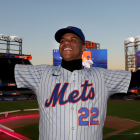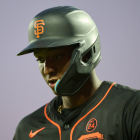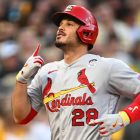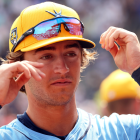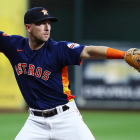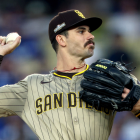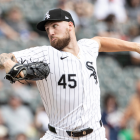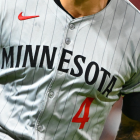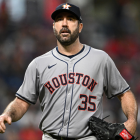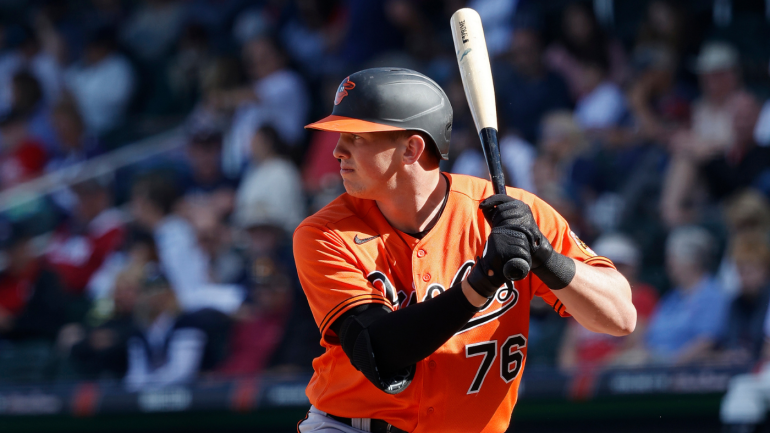
The arrival of the offseason means that it's time to rank stuff. Already this winter, we've sized up the 60 best free agents, both on an overall and positional basis. There's no law that prevents us from ranking minor-league players in addition to their big-league counterparts. As such, we're going to spend the winter evaluating every team's farm system.
The lack of a minor-league season makes that more of a challenge this year. It doesn't help that some teams opted against sharing video and data from their alternate-site camps with the rest of the league. As such, we've opted against overthinking this. Our rankings will essentially be the same as they were last winter with a few changes. First, we'll exclude anyone who graduated by exhausting their rookie eligibility; second, we'll replace them with draftees or other worthy prospects; and third, and lastly, we'll present the information in a new format.
In every article in this series, you'll find a team's top five prospects as well as five others we felt like including, either because of their promise or some other reason. For those top five prospects, you'll find a quick summation of their pros (their saving grace, if one will) and their cons (their fault line), as well as beefier report and our attempt to peg their "likeliest outcome."
These rankings were compiled by talking to industry folks -- scouts, analysts, and other evaluators -- and include a touch of our own evaluative biases. Remember, that this is more of an art than a science, and that the write-ups matter more than the rankings themselves.
Now, let's get on to the top five prospects in the Baltimore Orioles system.
1. Adley Rutschman, C
Age (as of 4/1/2021): 23
Height/Weight: 6-foot-2, 220 pounds
Acquired: No. 1 pick in the 2019 draft (Oregon State)
Highest level: A-ball
Saving grace: All-Star ceiling
Fault line: Speed
Scouting report: Rutschman has the potential to graduate with plus grades for every tool except speed -- and remember, he's a catcher, so that's almost irrelevant. He's a switch-hitter with similar swings and skill sets from both sides. Rutschman has a good eye; the strength to hit for power; and the bat control and barrel awareness to collect a solid average. Defensively, he grades well as a receiver; he has a strong arm; and he has the makings of being a field general. You almost have to go looking for knocks against him. Even then, the biggest blemishes are … his 12 games' worth of struggles in A-ball? His past medical concerns that no longer seem relevant? How about the fact that he probably doesn't play for your favorite team? He's going to be good, very good, and he should reach that ceiling sooner than later.
Likeliest outcome: High-grade starting catcher
2. Grayson Rodriguez, RHP
Age (as of 4/1/2021): 21
Height/Weight: 6-foot-5, 220 pounds
Acquired: No. 11 pick in 2018 draft (Central Heights High School, Texas)
Highest level: A-ball
Saving grace: Size, upside
Fault line: Command
Scouting report: Rodriguez is a large, physical right-hander who wouldn't look out of place if he started a big-league game tomorrow. He has two high-quality pitches in his fastball and breaking ball, and a developing changeup that at last check had one of the largest velocity gaps in professional baseball. Rodriguez will have to continue to work on smoothing out his delivery, as is often the case for high-school draftees with 113 innings, but there's a lot to like here and it shouldn't come as a surprise if someday down the road he occupies the top spot in the system.
Likeliest outcome: Mid-rotation starter
3. Heston Kjerstad, OF
Age (as of 4/1/2021): 22
Height/Weight: 6-foot-3, 220 pounds
Acquired: No. 2 pick in the 2020 draft (Arkansas)
Highest level: NCAA
Saving grace: Adaptable swing and power
Fault line: Approach
Scouting report: Kjerstad went off the board earlier than expected, with the Orioles snatching him instead of the likes of Austin Martin, Asa Lacy, and Emerson Hancock at No. 2. Baltimore clearly believes he has a chance to develop into a middle-of-the-order fixture thanks to his above-average strength and an adaptable swing that allows him to barrel-up pitches despite a bad-ball appetite. Kjerstad sliced into his strikeout rate during the shortened season; it's to be seen if that's an improvement or a small-sample mirage. Either way, it helped get him paid.
Likeliest outcome: Some approximation of Corey Dickerson
4. DL Hall, LHP
Age (as of 4/1/2021): 22
Height/Weight: 6-foot-2, 195 pounds
Acquired: 21st pick in the 2017 draft (Valdosta High School, Georgia)
Highest level: High-A
Saving grace: Above-average arsenal
Fault line: Consistency
Scouting report: Hall is a good athlete who could have three above-average or better pitches, including a fastball that can touch into the upper-90s. Why isn't he higher on the list? Because when we last saw him in 2019, he allowed more walks (54) than hits (53) in 80 innings. The inconsistency of both his command and his pitch quality makes it hard to know what to make of him heading forward. There's a chance he makes this look like either an under- or an over-rank, depending on whether or not he can start repeating his release point more frequently. In other words, the range of outcomes is wider with Hall than it is with anyone else in the top five.
Likeliest outcome: Frustrating mid-rotation starter, maybe?
5. Yusniel Diaz, OF
Age (as of 4/1/2021): 24
Height/Weight: 6-foot-1, 210 pounds
Acquired: Part of the Manny Machado trade (Dodgers)
Highest level: Double-A
Saving grace: Almost ready
Fault line: Health
Scouting report: Part of the return on Manny Machado a few summers ago, Diaz has a chance to be a decent corner outfielder who starts for a few seasons until the Orioles (or whomever) can find an upgrade. He can hit a bit, and in 2019 he improved his power output by pulling the ball more frequently. It's to be seen if that carries over heading forward. One aspect of Diaz's game the Orioles hope doesn't hang around? His health woes. He hasn't played in 100 or more games since 2017. If he can change that in 2021, he'll likely end the year in the majors.
Likeliest outcome: Short-term starter
Five others to know
- Adam Hall, SS
It's Hall who loses his spot in the top five to make room for Kjerstad. He's a shortstop who seems more likely to stick at the position now than he did as a prepster. What's more is that Hall hits the ball hard (albeit mostly on the ground), and he does a good job of controlling the zone. He can run, too, suggesting he should have a career as a reserve, at absolute minimum. - Ryan Mountcastle, LF/1B
Yes, Mountcastle somehow still has rookie eligibility remaining. He reached the majors late last season, performing well in a small sample. The concerns with Mountcastle's game have been for years his swing-happy approach and his lack of a defensive home. He walked at a higher frequency during his big-league stint than he had at any minor-league level for any duration of time (though he punched out three times as often) and, while he wasn't good in left field, the Orioles will take it so long as he hits for average and power. We suppose you can call those positive developments. May he experience more of them heading forward. - Zac Lowther, LHP
Lowther doesn't have good stuff; he does have a deep release point; a deceptive delivery; and a lower release point that has so far bedazzled minor-league hitters. Will it work as well against big-leaguers? That's to be seen. On the bright side, it should be seen before 2021 concludes. - Jordan Westburg, SS
The Orioles used their second first-round pick, No. 30 overall, to pop Westburg from Mississippi State in 2020. He's a good athlete with the footspeed and arm strength to stick on the left side of the infield. He also has a 6-foot-3 frame that lends itself to above-average power potential. Westburg cut into his strikeout rate during the shortened season, which seems like a good sign if he's going to make the most of his physical gifts. - Terrin Vavra, SS
Acquired in the Mychal Givens trade, Vavra hit .318/.409/.489 with 43 extra-base knocks and as many walks as strikeouts in his first pro season. The Rockies felt he was expendable because of the concerns about his long-term defensive home and his lack of a carrying tool. Vavra might have just enough in the tank to be a second-division starter at the keystone. It seems more likely that he's a reserve when all is said and done.










